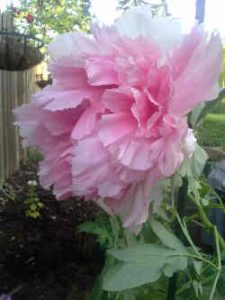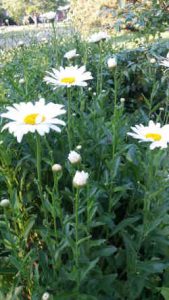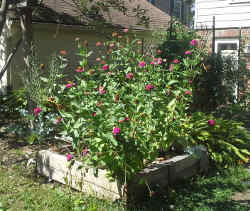
It’s not you. It’s your soil.
The soil quality in a typical neighborhood setting is usually pretty terrible. Although most people do not realize it, poor soil is the reason why backyard vegetable gardens do not perform to our expectations.
It can be frustrating when one spends so much time putting in and maintaining a traditional backyard vegetable garden to have it turn out, well…sad looking.
Do you ever see someone’s vegetable garden with 12 feet high tomato plants and jungle cucumbers and think, “What am I doing wrong?” You may blame it on a lack of a green thumb.
The truth is that your soil is not fertile. Another related problem is that you are over gardening. OK it is you, but we can fix this very easily.
 What is soil fertility?
What is soil fertility?
Without getting too scientific, very fertile soil grows giant, lush, beautiful plants! It’s the secret behind the green thumb, well one of them anyway.
Take an average suburban garden plot and drop a cosmo seed onto it and it may get 2 feet high. Grow the same seed in a high fertility garden and it may get 12 feet high.
Why is typical Backyard soil not very fertile?
In a nutshell it is because we don’t allow it to become that way.
Backyard soil is not very good in terms of fertility for a number of reasons. One issue is that the typical backyard consists of 90% lawn.
If one’s entire property consists of one type of plant, say Kentucky Bluegrass, it is not optimal for the soil.
Permaculture folks would say that this type of backyard ecosystem consists of a monoculture, meaning that we are forcing nature to allow only one thing to grow, in this case grass. “Nature” would normally grow a whole diverse variety of plants in our backyard if we were to allow it.
But by continuously mowing, spreading weed & feed, raking, and other activity, we have cultivated a space where only grass and weeds will grow.
Monocultures are not sustainable
In North Central Ohio, we have a lot of corn fields which is a great example of a monoculture. Nature would never allow a gigantic field of nothing but corn to grow on its own, so in order to accomplish this feat, farmers use artificial fertilizers, pesticides, and herbicides.
Tilling and spraying keeps the corn alive and pretty much everything else dead. The soil is not naturally fertile, but relies on the artificial fertilizer which has to be continuously replenished.
The system is not sustainable, meaning that these artificial inputs are required year after year.
A forest, on the other hand, is not a monoculture and is sustainable. No one goes into the forest to weed, fertilize, or kill bugs, yet the trees are gigantic and getting bigger, and the soil is incredibly fertile.
There is a diverse selection of plants, animals, and insects and the whole system works together in a balanced way. As the forest is left alone to do its thing, the soil there increases year after year. This concept is better explained by Toby Hemenway in his remarkable book, Gaia’s Garden.
Backyard Soil Compaction and Erosion
Another reason that our backyard soil is not very fertile has to do with soil compaction. The typical backyard soil is very compacted, in other words, tightly packed down.
My grandparents used to have a large roller filled with water (or sand if you wanted to) that they would roll over the lawn a few times a year to make sure there were no lumps.
They also used to park cars on the lawn during Thanksgiving and other events. This is compaction. If you have ever felt the soil in a lush garden, you will notice that it is fluffy–not compacted.
When soil gets compacted, nature is not allowed to get certain things done that it normally would. There is a whole science of soil and I’ll not go into any of it, but it is better from a fertility standpoint to leave the soil alone as much as possible and to let nature do its thing, just like it does in the forest.
Soil Erosion
During medium and heavy rains, water rushes over compacted soil very easily, like it runs over a driveway easily; sweeping away the top-most layers of the soil with it. Anything we may have done to build up the soil gets literally washed away.
Over time, backyard soil fertility will naturally increase if allowed to do so, and one way nature does this is by dropping organic materials on top of the soil which slowly decompose and become part of the topsoil (think: leaves, pine cones, manure, etc.).
When you mow, if you mulch the clippings back into the lawn as is recommended, these will eventually breakdown and improve the fertility of the soil.
Also, if you were to spread topsoil or compost, these things would generally improve the backyard soil quality…but not if the top layer of backyard soil is regularly washed away by rainwater into the street.
 What to do to Improve Backyard Soil
What to do to Improve Backyard Soil
Shift your thinking.
Using Permaculture and other backyard farming concepts, your backyard soil could be allowed to gain fertility year after year, but this will only be possible if there is a shift from traditional lawn care and gardening methods, to Permaculture-based thinking.
The big idea in Permaculture is that nature knows what it is doing, and that we should observe it, and use it to our benefit rather than trying to fight with it, as in the monoculture example.
What Would Nature Do?
So how do you raise the fertility of your soil? Permaculture theory goes like this: If you took a well-manicured lawn and began to neglect it, what would happen? As already mentioned, Toby Hemenway lays this idea out wonderfully in his book, Gaia’s Garden.
First your grass would get very high. Stay calm, this is just a thought experiment.
Later some crazy looking weeds would start to show up. These are the weeds that can basically grow anywhere; you know the ones, the worst of the worst weeds in terms of aesthetics to the lawn purist.
These weeds would eventually take over and thrive because they are the kind that can send down deep tap roots to break through the compacted soil and concrete if necessary to get down to the nutrients and water. They have adapted to live in low fertility environments.
Later, once enough of these weeds began to dominate, they would start to thrive and flower, drop seeds, die, regrow, and so on. Through this process, more and more plant material (read: organic mulch) would start to build up in the soil. More water would start to become retained in the soil because this organic waste buildup is spongy.
Now, there would no longer be a grass monoculture but a diversity of crazy weeds and all kinds of insects and critters will start to be attracted to the various berries, seeds, leaves, etc. Things are starting to eat things and die, lay eggs, decompose, poop, etc.
Later, some Maple saplings are starting to grow up and the ones that do well are going to start crowding out some of the weeds. Squirrels are burying acorns, you get the picture. Fast forward many years and there is a full-on forest that cannot be stopped.
Nature has converted your lawn into a mature forest and the fertility of your soil has grown exponentially. No one watered anything and no one laid down any mulch or fertilizer. No one did anything.
Mimic Nature to Improve Backyard Soil Fertility
Obviously we do not want to let our backyard run wild on its own, but we do want to raise the fertility of our backyard soil, so what should we do?
The answer is that we should let nature raise the fertility of our soil for us when tolerable, but stop nature from taking over things that we do not want it to take over.
The first step is to realize that we are probably over-gardening everything. When possible, one should leave things alone and only step in when it is necessary for getting the plants and crops that we want and maintaining the look that we want.
We can grow a food/flower forest that looks however we want it to look, by stepping in and substituting a tap root weed for a radish plant and a Maple sapling for an Apple sapling, so to speak.
Get rid of your Lawn Monoculture
The first thing to do is to get rid of the lawn monoculture. See our article on Backyard Design and Converting Lawn to Garden (here) and the one on the double dig, which is a great way to loosen and prep the soil for the first time (here).
Using these skills, you can slowly begin to turn lawn to garden space. Of course, you can still have a lawn. Lawns are wonderful, but they need to be contained to a realistic portion of the overall property.
Confining a lawn to a smaller space will allow you to actually have a more beautiful lawn anyway, because your soil will improve.

Once the lawn is in check, the next thing to do is to take on the problem of backyard soil compaction. One should try to commit to only walking on walkways and on the lawn, but not in the garden areas.
Pathways can be built for access as needed. (also, don’t use the roller thing, or park cars in your yard…)
As discussed above, we can substitute weeds that have taproots for desirable plants that also have deep tap roots. Things like radishes, turnips and potatoes will certainly help with compaction.
Comfrey is a great plant grown for medicinal properties than has large tap roots. Dandelion is also a good one. Read our article on eating dandelions (here). A quick search of vegetables, flowers, and medicinal plants with deep tap roots will produce a wealth of ideas.
Honestly, planting just about anything will help with compaction.
Another key to fighting compaction is to never have bare soil. This rule should always be followed. During the growing season, this means using mulch around plants.
Mulch can be grass clippings, leaves, compost, hay, or composted manure to name a few. When the season is over and the garden dies, make sure you are covering that soil with either a cover crop (something you grow to mulch in later, such as buckwheat
) or heavy mulch.
The bottom line is, don’t leave soil bare. The forest doesn’t have bare soil…
Backyard Soil Erosion can be fought in many ways. Improving compaction will help since water moves faster over hard ground. Another thing to do is to observe the backyard during a heavy rain.
Where is the water flowing? If you observe water rushing from one place in the yard to another, and ultimately leaving the property, your topsoil is going that way as well.
Water should not be allowed to rush over the ground and leave your property, taking soil with it. For one you lose the soil, but you also don’t get to keep the water.
Ultimately we want to catch the water or at least slow it down so that it can soak into our soil. The following things can be done to combat this issue.
Swale / Hugelkultur combination on contour
This is discussed in our article on hugelkultur in home gardens, but briefly, a swale is a ditch and a Hugelkultur bed is a mound. If you dig a swale on contour it means that you position it to catch water (not to channel it away as most people use swales for).
{aside: I once built a massive French drainage system in my yard to make sure that all water was whisked away to the street as efficiently as possible. For the water that was still sticking around, I “swale’d” it over to my neighbor.
We work against ourselves.
These days I do the opposite; I try to catch all of the water and get it into my garden beds, so there is less watering and more fertility. I even channel it from my roof into rain barrels and/or the garden beds.}
If water is running North to South, you dig a swale on contour East to West. A swale can be dug 1 foot wide, and spanning as long as needed, and the ditch part can be filled back in with compost, gravel, or wood chips, leaving it invisible and level to the ground.
To be more effective, on the other side of the swale there could be a Hugelkultur mound (garden berm) which would further stop or at least slow the water flow.
A Hugelkultur mound is basically wood laid out on the ground (in this case, on contour) and covered with soil (in this case the soil you removed from the swale). The wood soaks up water for later, and plants positioned all around this feature help soak up even more water.
 Raised beds
Raised beds
Raised beds keep the soil from being washed away…at least the soil inside the raised bed. I prefer Hugelkultur beds to raised beds when possible, although arguably raised beds
are more attractive.
Other water management tools
Rain Garden: Rain gardens are special features designed to catch rain water.
Plants: A variety of plants large and small, can be planted strategically throughout the property to soak up water and to slow down and disrupt the flow of water.
Mulch: Mulch soaks up water for the plants to use later.
Additional ways to raise fertility in Backyard Soil
Food Forest
Following with the Permaculture thought experiment above, a neglected lawn would soon start to send in weeds to fight compaction, and as discussed we can swap these out for more desirable plants.
Furthermore, as the soil gets more mature, we can design a whole variety of plants and trees to fit in, ultimately building up to having our own “forest”, a food forest, right in the backyard.
Check out our article on Permaculture Zones and Backyard Farming.
 Mulch
Mulch
One way to really boost fertility in your backyard soil is to lay down lots and lots of mulch. If you had a mature food forest, there would be lots of natural mulch falling everywhere, so to help get to this point, you can bring in mulch from elsewhere.
Once your compost is used up, go and get things like hay bales and heavily mulch around existing plants. In the fall, you can lay mulch three feet high if you want to (we do).
Anything that does not break down can always be pulled back and composted the following Spring.
Other great mulches besides hay include composted manure, grass clippings (although I always leave these on the lawn), and leaves. See our article on how raking leaves is bad (here).
Leaves are a wonderful mulching material and can be used liberally in the garden, or put into the compost bin.
Chop and Drop
Another great method for improving soil fertility, is called the chop and drop method. This means that as you come across unwanted weeds in the garden, cut them off at ground level, cut them up, and drop them down right there as mulch. (don’t pull them out as we are taught; let the roots stay in the ground to decompose). A Hori hori gardening knife is ideal for this.
Pruning’s can also be chopped and dropped. This is a form of “composting in place.” Also, observe weeds and let some of them live if they are not hurting anything. Remember they are there to help your soil quality.
Dynamic Accumulators
Dynamic Accumulators is another term tossed around that refers to plants that send down deep tap roots and bring up from deep in the soil, nutrients that may not be present up top.
These beneficial nutrients get distributed throughout the plant, and the leaves can be chopped and dropped into the garden as a “green manure.” A good example of a dynamic accumulator is Comfrey. Comfrey grows like crazy and can be cut back a few times a year.
Following these more natural growing methods, your soil will start to take off and shoot up the fertility scale. Make sure you stop the use of all chemical and artificial applications like pesticides, artificial fertilizers, and herbicides.
We want to encourage lots of different bugs and weeds to come into our garden, so there is a balance. (some of your plants will get chewed on and that’s OK)
Yard “waste” is now prized mulch. Weeds and critters are good. Lawns are no longer our rulers. Variety is good. Switching over to this way of gardening, you will see your soil improve year after year!
Sources:
- Gaia’s Garden: A Guide to Home-Scale Permaculture by Toby Hemenway
- Anything by Sepp Holzer
- Permies.com
- The One-Straw Revolution
by Masanobu Fukuoka

